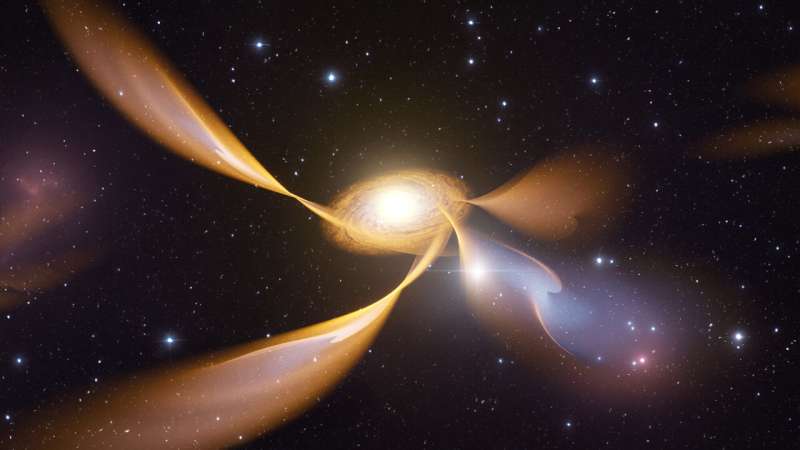This article has been reviewed according to Science X's editorial process and policies. Editors have highlighted the following attributes while ensuring the content's credibility:
fact-checked
peer-reviewed publication
trusted source
proofread
Dutch astronomers prove last piece of gas feedback-feeding loop of black hole

Three astronomers from the Netherlands have proven that gas that was previously heated near a supermassive black hole flowed to the outskirts of the galaxy and cooled down, moving back towards the black hole. While there had been indirect evidence for this theory, this is the first time that the cooled gas moving toward the black hole has actually been observed.
The researchers made their discovery when they used new techniques to examine archived data from the ALMA observatory. They share their findings in Nature Astronomy.
Supermassive black holes at the centers of galaxies have long been known to emit enormous amounts of energy. This causes the surrounding gas to heat up and flow far away from the center. This, in turn, makes the black hole less active and lets cool gas, in theory, flow back.
Three researchers from ASTRON, the University of Groningen, and JIVE have now indeed shown that cool gas is flowing back. In this case, it was cold carbon monoxide gas, but other cold gases are likely to flow back.
The astronomers used data collected by the ALMA observatory from the iconic galaxy 3C 84 (also referred to NGC 1275 or Perseus A). That galaxy is located 235 million light-years away in the northern constellation of Perseus. It is the textbook example of what astronomers call "AGN feedback," or the recirculation of gas near a black hole. It had been known for decades that plasma jets from the supermassive black hole disrupt the hot gas around 3C 84 and that filaments of colder gas float in and around the system.
It had long been assumed that those filaments fall back toward the black hole, but it had never been proved.
"The data we used had previously been examined by another team of scientists," says lead researcher Tom Oosterloo (ASTRON and University of Groningen). "They couldn't remove the noise. We could. We used a new calibration technique that allowed us to image areas near the black hole three times sharper. And that is when we could detect the cool carbon monoxide gas flowing back."
In the future, the researchers plan to also map the flow of gas molecules other than carbon monoxide.
The research by Oosterloo and colleagues is unrelated to the study by Takuma Izumi and colleagues published in Science on November 3, 2023.
Izumi investigated what happens to gas once it arrives in the gas disk near a black hole. Oosterloo and co-workers track gas moving from far away toward such a gas disk. Oosterloo and his team study what happens on a larger scale around a black hole and studying how that correlates with the evolution of the corresponding galaxy. Izumi's group focuses mainly on how a black hole is fed.
More information: T. Oosterloo, et al, Closing the feedback-feeding loop of the radio galaxy 3C 84, Nature Astronomy (2023). DOI: 10.1038/s41550-023-02138-y. www.nature.com/articles/s41550-023-02138-y
Journal information: Science , Nature Astronomy
Provided by Netherlands Research School for Astronomy





















